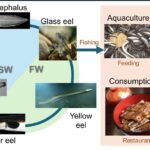Spain – A research group from the URV and the Pere Virgili Health Research Institute have analysed the concentration of various toxic elements in these foods and evaluated the risk of consuming them in infant, adolescent and adult populations.
Eight pieces of salmon-based maki, nigiri or sashimi or maki unagi (eel) is the safest combination of sushi for adult and adolescent populations. That is one of the findings of TecnATox (Centre for Environmental, Food and Toxicological Technology), a joint research group from the URV and the Pere Virgili Health Research Institute (IISPV), which has analysed the presence of arsenic and various heavy metals in sushi. The consumption of sushi has increased significantly since the start of the 21st century, as has the number of restaurants offering it throughout the region. Although eating fish is recommended because of its high nutritional value, it can also lead to exposure to contaminants, such as heavy metals. Likewise, rice is a food that provides many nutrients and fibre and is low in fat, but it too can be source of pollutants such as arsenic.
The research group analysed the concentrations of various toxic elements (cadmium, nickel, lead, mercury, inorganic arsenic and methylmercury) and iodine in a hundred pieces of sushi, specifically those known as sashimi (raw fish), maki (a seaweed roll stuffed with rice, raw fish or other ingredients) an nigiri (balls of rice with fish or seafood on top). The researchers also calculated dietary exposure to all of these contaminants in various population groups (infants, adolescents and adults) and evaluated the risks to health.
The main results show a significantly higher concentration of inorganic arsenic in maki and nigiri, compared to sashimi, a finding associated with the presence of rice. They also show higher levels of mercury and methylmercury in sushi that contains tuna due to the bioaccumulation and biomagnification of this metal.
The research group also wanted to determine how consumption of this foodstuff varied in different groups of the population. They examined an average intake of 8 pieces of sushi in adults and adolescents and an average intake of 3 pieces in infants and found an increase in exposure to nickel and lead, although this remained within safe established levels. “The most worrying finding concerns methylmercury, a highly neurotoxic compound, for which there was an estimated exposure of 0.242 µg per kg of bodyweight in adolescents, a value higher than the safe daily limit established by the European Food Safety Authority (EFSA)”, explained Montse Marquès, one of the researchers who worked on the study. By the same token, although not as high as in adolescents, the exposure levels calculated for adults and infants also suggest a relatively high intake of methylmercury.
Finally, the results were analysed as a whole to determine which combinations of sushi do not represent a risk. “We recommend that people combine 8 pieces of salmon-based maki, nigiri or sashimi or maki containing unagi (eel) and limit their consumption of any type of sushi containing tuna”, warned Marquès.
The researchers stressed that the amounts of sushi analysed constitute only one of the five recommended meals a day. This means that the consumption of other foods throughout the day may also lead to exposure to certain toxic elements, such as arsenic (present in rice and rice-based foods), mercury (present in tuna and swordfish) or nickel (present in vegetables, pulses and cereals).
Stay Always Informed
Join our communities to instantly receive the most important news, reports, and analysis from the aquaculture industry.
Due to its nutritional benefits, the researchers still recommend the consumption of sushi, but they also stress the need to do so in moderation in order to minimise the intake of certain food toxins.
Reference (open access):
Neus González, Eudald Correig, Isa Marmelo, António Marques, Rasmus la Cour, Jens J. Sloth, Martí Nadal, Montse Marquès, José L. Domingo. Dietary exposure to potentially toxic elements through sushi consumption in Catalonia, Spain. Food and Chemical Toxicology, Volume 153, 2021, 112285, ISSN 0278-6915. DOI: 10.1016/j.fct.2021.112285
Source: Universitat Rovira i Virgili
Editor at the digital magazine AquaHoy. He holds a degree in Aquaculture Biology from the National University of Santa (UNS) and a Master’s degree in Science and Innovation Management from the Polytechnic University of Valencia, with postgraduate diplomas in Business Innovation and Innovation Management. He possesses extensive experience in the aquaculture and fisheries sector, having led the Fisheries Innovation Unit of the National Program for Innovation in Fisheries and Aquaculture (PNIPA). He has served as a senior consultant in technology watch, an innovation project formulator and advisor, and a lecturer at UNS. He is a member of the Peruvian College of Biologists and was recognized by the World Aquaculture Society (WAS) in 2016 for his contribution to aquaculture.




